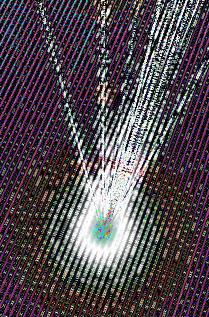Light excites new sensors
 Engineers have developed a new way to measure neural activity using light – rather than electricity.
Engineers have developed a new way to measure neural activity using light – rather than electricity.
A UNSW team has demonstrated in the lab what it had already proved theoretically; that sensors built using liquid crystal and integrated optics technologies - dubbed ‘optrodes’ - can register nerve impulses in a living animal body.
Not only do these optrodes perform just as well as conventional electrodes - which use electricity to detect a nerve impulse - but they also address “very thorny issues that competing technologies cannot address”, says lead researcher Professor François Ladouceur.
“Firstly, it’s very difficult to shrink the size of the interface using conventional electrodes so that thousands of them can connect to thousands of nerves within a very small area,” he said.
“One of the problems as you shrink thousands of electrodes and put them ever closer together to connect to the biological tissues is that their individual resistance increases, which degrades the signal-to-noise ratio so we have a problem reading the signal. We call this ‘impedance mismatch’.
“Another problem is what we call ‘crosstalk’ – when you shrink these electrodes and bring them closer together, they start to talk to, or affect each other because of their proximity.”
But because optrodes use light and not electricity to detect neural signals, the problems of impedance mismatch are redundant and crosstalk minimised.
“The real advantage of our approach is that we can make this connection very dense in the optical domain and we don’t pay the price that you have to pay in the electrical domain,” Prof Ladouceur says.
In their recent experiment, the team wanted to show that they could use optrodes to accurately measure the neural impulses as they travel along a nerve fibre in a living animal.
They connected an optrode to the sciatic nerve of an anaesthetised animal. The nerve was then stimulated with a small current and the neural signals were recorded with the optrode. Then they did the same using a conventional electrode and a bioamplifier.
“We demonstrated that the nerve responses were essentially the same,” says researcher Professor Nigel Lovell.
“There’s still more noise in the optical one, but that’s not surprising given this is brand new technology, and we can work on that. But ultimately, we could identify the same characteristics by measuring electrically or optically.”
So far the team has been able to show that nerve impulses - which are relatively weak and measured in microvolts - can be registered by optrode technology.
The next step will be to scale up the number of optrodes to be able to handle complex networks of nervous and excitable tissue.







 Print
Print